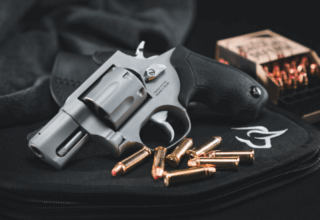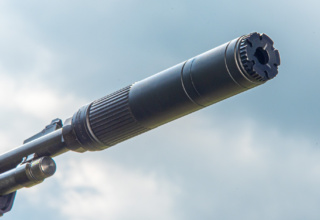Thought the Taurus G2c hit all the right buttons for an EDC handgun? The all-new G3c just raised the ante.
by Rob Reaser
There’s no doubt Taurus nailed it when the company rolled out the PT111 (alternately called the Millennium G2 and the PT111 G2) or, as it is billed today, the G2c (the latest iteration released in 2018). Whichever tag you want to hang on it, this dynamite of a compact handgun delivered high on the performance and ergonomics quotients at a price well below that of similar polymer-frame striker-fired 9mm pistols offered by the “halo brands.” Consumers seemed to find the menu agreeable as well because the G2c (and its name-adjusted predecessors) has been among the best-selling personal defense handguns since the platform’s introduction in 2013.
Over the last couple years, Taurus has enthusiastically focused on refining the polymer-frame striker-fired pistol. The first volley came with the launch of the Taurus TX-22 — a full-size, “factory custom” semi-auto chambered in .22LR that is not only sophisticated in its design and performance, but also answers the call as a serious trainer for those being introduced to shooting and for experienced gun handlers who want to keep their skills sharp without depleting their ammo budget.
The TX-22 was followed by last year’s introduction of the Taurus G3 9mm. Basically, this is the answer to all those Taurus fans who, while favoring the compact G2c, prefer a full-size semi-auto defensive handgun. If you were to upsize the G2c and add a few special tweaks, such as a more ergonomic frame, redesigned trigger, and a steel guide rod and spring assembly, you have, in essence, the G3 — so-named for being the third generation of the Taurus G-series pistols.
Now, Taurus continues the G-series lineage with the all-new G3c. This will be counted as the third generation of the compact polymer pistol. Those tuned to the ways of Taurus will likely take a few quick, excited glances at the G3c and say, “Hey…it looks like the G2c!”
Well, it does, but it doesn’t.
To be fair, the same bug bit us when we received our early-production sample. Some changes were readily apparent, such as the slide and trigger. Other changes were revealed only when we compared the G3c side-by-side with our Millennium G2, which has been our daily carry gun for the last four years or so.
All-New Frame
From an arm’s-length view in sketchy lighting, the G3c’s black polymer looks like that of the G2c, but closer inspection bears out the modifications. The overall profile is the same, with slight adjustments here and there. Starting with the grip, the four stipling panels on the grip panels (two per side) are larger, providing more no-slip acreage. The stipling along the backstrap is slightly narrower but is longer, placing the stipling a bit higher on the palm. The front patch is also larger. In sum, there is more stipling to keep the gun secure in sweaty hands.
One thing we noticed immediately was that the stipling really bites into your hand more than that of the G2c. Not in a bad way, of course, but in a manner that says, “I’m sticking with you no matter what.” At first, we weren’t quite sure why the G3c gripped with such tenacity compared to the G2c grip (which is one of the hallmarks of that pistol). The stipling profile looks to be the same, however, a worm’s eye view of the grip reveals that the G3c’s stipling patches are raised slightly above the rest of the frame. This accounts for the much better 360-degree purchase. And we like it!
More familiar frame features include the front and rear ambidextrous “memory pads.” These are shelfed recesses in the frame to accommodate firing and non-firing hand thumb placement — convenient for helping achieve a repeatable grip and to promote good shooting form. The memory pads on the G3c are crisper in edging than its predecessor, while the firing hand thumb pads are larger and have a more prominent shelf along the bottom for better support.
As best we can tell, the trigger guard is dimensionally the same, but Taurus did modify the accessory rail. It’s slightly longer than that of the G2c, so it should more easily accommodate a wider variety of aftermarket lights and lasers.
Although the magazine is not technically part of the frame, the G3c mag’s extension makes it integral to grip performance. Interestingly, the three 12-round capacity mags that came with our test model are (almost) the exact same ones used for the G2c. A 10-round magazine is also available for the G3c, but not having one on hand, we can’t tell you anything other than the base plate profile is probably the same as that of the 12-round mag.

The “almost” mentioned above refers to the G3c’s subtle grip/magazine extension recess. Although the magazine has a rather energetic spring to it when the release lever is depressed, Taurus thought it utilitarian to add scallops along the seam of the mag extension and the bottom of the grip to assist in tactical mag swaps should grit, dirt, or other substance interfere with a smooth mag drop.
All-New Slide
Whereas the G3c’s polymer frame represents a slight evolution of the G2c frame, its slide assembly is a direct take-off of the slide sported by its G3 big brother. Other than a change in the rear sight dovetail (more on that in a moment) and the sight being dimensionally smaller, the G3c slide is identical to that of the G3. Gone is the G2c’s deep scalloping forward of the ejection port. The slide has a more “squarish” profile along its entire length, and, like the G3 slide, there are now serrations up front. These forward serrations give your non-firing hand better purchase if you’re a shooter who likes to manipulate the slide from underneath (not sure why you would want to, but there you go) or from the front.
Also different is the chamber indicator. The G2c uses a mechanical indicator that pushes above the slide when a round is in the chamber. Simply rub your finger across the slide and you know if there is a round in battery or not. That’s gone on the G3c. Less parts and lower production cost. The notch in the barrel lug, however, remains with the G3c, so now you have a visual chamber indicator. Look down the slot. If you see brass, there’s a round in. If you don’t, the chamber is empty.
Another upgrade for the G3c can be found in the finish. Black oxide has been replaced with Tenifer, which Taurus explains will better reduce scuffing and enhance corrosion resistance. For the operational controls, meaning the disassembly lever, slide stop lever and the manual safety lever, Taurus selected Teflon not only for its corrosion-resistant properties but also to reduce friction. The latter seems valid, because there is noticeably less effort required to manipulate the G3c’s safety lever than that of our G2c that now has years of wear under its belt.
On the mechanical side, the G3c workings are familiar territory if you’re accustomed to the G2c. It’s the same striker-fire system with restrike capability (if you have a failure-to-fire condition, the firing pin return spring allows you to simply pull the trigger for another go at the cartridge…after that, you better be ejecting that round!). The G3c continues the tradition of a dual internal/external recoil spring.
Topside, you will immediately note the new rear sight setup. Gone is the windage- and elevation-adjustable polymer sight with its large dovetail cut footprint. In its place — a robust, all-steel rear sight with a serrated ramp. The supplied specs call for two white alignment dots, as is the way of most Taurus sights, but our sight was all black. That could have been an issue with the pistol being a pre-production model. Whatever, we prefer our open sights sans white dots anyway, so no biggie.
What is most welcome is the new dovetail cut that accompanies this more robust steel sight. The fact is that most defensive-minded and EDC folks favor tritium night sights. We certainly do. The problem Taurus G2c owners have is finding tritium aftermarket sights that are compatible. TRUGLO leads in that area with several offerings, and XS Sight Systems makes one set for the G2c. That’s about it. Owners of other brand pistols (such as GLOCKs) on the other hand, enjoy a multitude of tritium sight options from several manufacturers. Knowing that consumers like a broad range of customizing choices, Taurus designed its rear sight dovetail to be dimensionally compatible with those popular aftermarket sights (i.e. GLOCK), throwing the door wide open for myriad night sight options. Good call. TRUGLO and Rival Arms are already out of the gate with their tritium sights for the G3c. If you’re all about lasers, Viridian has announced its E-series red laser is also compatible with the new G3c.
While we’re on the topic of aftermarket goodies, holsters are already available for the G3c from CrossBreed Holsters and N8 Tactical.
On the Range
We’ve always appreciated the well-thought-out ergonomics of all the Taurus G-series pistols, and the G3c is no different. For small- and medium-sized hands, the G3c hits that “glove-like” note with ease. Those with larger hands should also feel close to home with this pistol, although shooters of the “sausage finger” variety may have to deal with the dangling pinkie. But while not all ham-fisted shooters may enjoy a three-finger grip, the aggressive and well-placed stipling will likely more than make up for it in terms of weapon control and retention.
The G3c trigger has a broader, flatter face than its predecessor. The break is decidedly crisper, with less creep and a smoother feel. What we like most, though, is that it has a shorter pull before the break. This has always been one of our biggest beefs with many single-action striker-fired pistols. The longer the pull, the more shooters will upset their sight alignment. The G3c’s shorter stroke gives it the definite advantage here.
It’s also an easy pull. Taurus did not provide the trigger’s pull weight, so we brought out the Lyman scale to test it ourselves. Cycling Snap Caps for each “shot” to determine first-pull weight, we made two 10-shot test pulls and averaged each set. The first ten pulls averaged 4 lbs., 5.4 oz. The second ten pulls averaged 4 lbs., 9.1 oz. Not too heavy, not too light.
The G3c comes with a 3.2-inch stainless steel barrel — same as the G2c — so we weren’t expecting any surprises in shot grouping. For our test, we used Fiocchi, Magtech, Black Hills, and our own utilitarian handloads. After blistering steel, we gave each load two five-shot groups at 10 yards to prove their mettle. Of the four, the G3c definitely favored the Black Hills diet. Both the Black Hills 5-shot groups, quite surprisingly, shot the exact same size. The best 5-shot groups for each ammo were…
- Black Hills 124 gr. JHP: 1.206 in.
- Handloads (Hornady 124 gr. RN): 1.53 in.
- Fiocchi 124 gr JHP: 1.801 in.
- Magtech 115 gr. RN: 2.085
As for overall function, the G3c scored all As. Across all four ammo types we tested, this pistol never experienced a function failure and we never got to test the gun’s restrike capability because there were no light primer strikes. In short, the G3c did exactly what a defensive handgun (or any gun) is supposed to do…go BANG every time you pull the trigger and be ready for the next trigger event.
Although this third-generation of the Taurus compact polymer 9mm is startlingly similar to its G2c predecessor, this is an all-new gun from frame to slide, with upgrades, refinements, and accommodations for aftermarket tritium sights. As such, you might expect that the price would be significantly upgraded as well. Not so. In all-black trim, a 12-round G2c carries an MSRP of $271.21. The G3c debuts at $305.74 — an easily swallowed $34.53 difference.
For what you get, that’s an up-cost we’d gladly pay.
Taurus G3c Specifications
- Caliber: 9mm Luger
- Capacity: 10- or 12-round
- Slide Finish: matte black
- Operational Controls Finish: Teflon
- Grip/Frame: Polymer
- Firing System: single action with restrike capability
- Action Type: striker
- Safety: manual, trigger safety, striker block and loaded chamber indicator
- Sights Front: fixed (white dot)
- Sights Rear: drift adjustable (white dots), serrated ramp
- Slide Material: alloy steel
- Overall Length: 6.3″
- Overall Width: 1.2″
- Overall Height: 5.1″
- Barrel Length: 3.2″ (stainless steel)
- Weight: 22 oz. (unloaded)
- Magazines Included: 3×10 or 3×12
- Packaging Size: 9.8″ L x 6″ W x 1.8″ H
- Packaging Weight: 33.20 oz.
- Additional Feature: Picatinny Rail (Mil-STD 1913)
- MSRP: $305.74
For A Chance To Win The NEW G3c CLICK HERE!






















